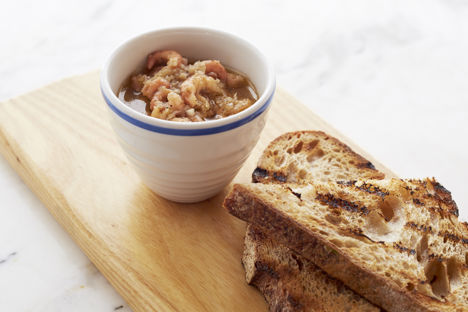The brown shrimp (also known as crangon crangon, bay shrimp or sand shrimp) is a small shellfish, similar in appearance to the prawn but with a smaller, flatter body. As the name suggests, they are greyish-brown when raw, but turn a vibrant pinkish-orange once cooked.
Shrimps are popular all over the world, from the intensely-flavoured fermented shrimp pastes eaten across south-east Asia, to serving whole unpeeled shrimps as a salty beer snack in Belgium. Here in the UK, brown shrimps are probably best known in the form of potted shrimp from Morcombe Bay, but they are also commonly found along the Norfolk coastline.
Once a thriving industry, due to overfishing and changes in fishing licences, shrimping in Morcombe has sadly almost died out. The Morecombe Bay shrimp was one of the first UK products to be added to the ‘Ark of Taste’; a catalogue of regional endangered foods. Set up by the global Slow Food movement, it aims to help raise awareness and prevent the decline and demise of certain traditional ingredients and preparation techniques.
What to look for when buying brown shrimp
Brown shrimps are cooked whilst still alive – if not, they turn mushy and are impossible to peel. Because of this, the shrimps are commonly boiled up on board the fishing boats, and you’ll most likely find them already cooked at the fishmonger. If buying unpeeled shrimps, as with other crustaceans, be sure to keep the heads and shells to make delicious umami-rich stocks and sauces.
Brown shrimp is most commonly found in potted form; preserved in butter with lemon juice and spices like mace, nutmeg and cayenne pepper. This is a traditional preserving method used before refrigeration, which not only helped them keep for longer but like curing or pickling, intensifies the flavour. See Josh Eggleton’s Potted shrimp with mace butter recipe to try it yourself. Serve at room temperature spread generously over toast.
Unfortunately, in some parts of the world brown shrimp are not the most sustainable seafood due to the fishing methods used to catch them. As the nets have to be fine enough to catch them, a lot of juvenile fish get caught up, plus some of the trawlers used damage the seabed. If you are going to eat brown shrimp, do so as an occasional treat and make sure they’re cold water trawled or farmed organically.
How to cook brown shrimp
Though you are most likely to find brown shrimps pre-cooked, if you do find fresh shrimps, they only need 45 seconds to a minute in a pan of salted boiling water before they can be peeled.
The sweet and salty, umami-packed flavour of the shrimp pairs naturally with other fish and seafood and a little contrasting acid such as lemon juice or capers. Richard Corrigan serves shrimps with scallops, salty monks beard and vibrant, tangy blood orange.
Bryn Williams cooks the shrimps in a classic beurre noisette with capers and parsley, and pairs with the underused cut of fish; the skate wing but the dish would work well with any white fish, particularly flat fish such as plaice or sole (see also Marcus Wareing's soles in coffins for another amazing shrimp sauce – this time a creamy and luxurious version flavoured with vermouth).
South-East Asian countries often dry out the little shrimps to preserve and intensify their flavour. They are then often fermented and made into a pungent paste or sauce, used to bring richness to soups, stews and curries, with each country having its own version with varying flavours and consistencies. Dried shrimps are used to add extra umami depth to Judy Joo’s Korean cabbage kimchi.
Get in touch
Please sign in or register to send a comment to Great British Chefs.



